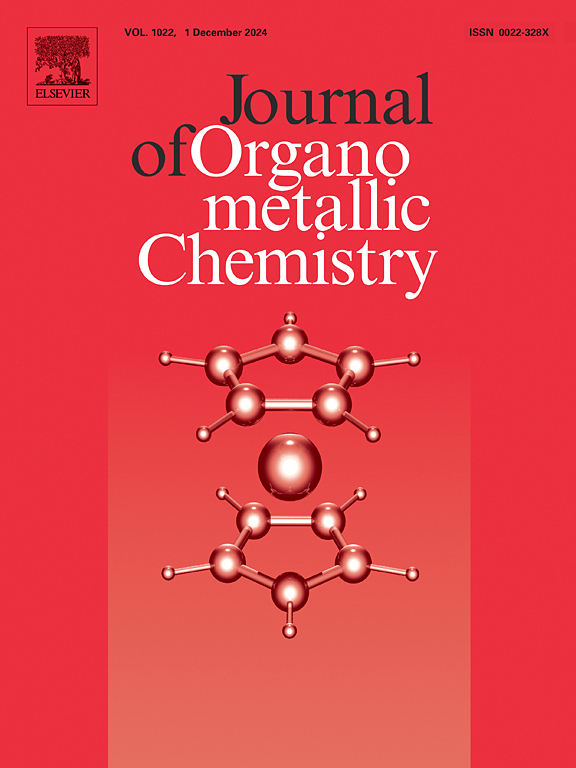N2/溶剂对小分子结合与配位不饱和钌螯合物稳定性的影响
IF 2.1
3区 化学
Q3 CHEMISTRY, INORGANIC & NUCLEAR
引用次数: 0
摘要
合成并表征了由弱结合的N2/溶剂分子稳定的配位不饱和[RuH(N2/solv)(CO)(PPhNNpPPh)][BArF4]配合物(2)。用拉曼光谱研究了N2配体在配合物2中的结合。配合物2中弱配位的N2/solv很容易被sigma给体取代,生成相应的阳离子配合物[RuH(L)(CO)(PPhNNpPPh)][BArF4] (L = CH3CN (3), CO(4)和H3B)。NMe3(5))。在243 K ~ 183 K的温度范围内,配合物2与H2反应生成[RuH(ƞ2-H2)(CO)(PPhNNpPPh)][BArF4]配合物(6)。通过对HD同位素体的变温(VT) 1H自旋-晶格弛豫时间(T1)测量和J(H,D)耦合测量,确定了配合物6中H2配体H - H键的完整性。配合物2与sihrr ' 2 (R = R ' =Et (7a), R = Ph, R ' = Me (7b))反应,在243 K ~ 183 K的温度范围内生成相应的σ-硅烷配合物。当反应温度高于243 K时,复合物2和游离硅烷被恢复,表明Si - H键的结合是可逆的。通过VT多核磁共振谱法确定了HSiEt3和HSiMe2Ph中Si - H键与金属中心的相互作用。此外,当配合物2与甲烷在高压(6 - 12 bar)下反应时,钌与甲烷的C−H键之间没有相互作用。本文章由计算机程序翻译,如有差异,请以英文原文为准。
Small molecule binding versus stabilization of coordinatively unsaturated ruthenium-pincer complex by N2/solvent
Coordinatively unsaturated, [RuH(N2/solv)(CO)(PPhNNpPPh)][BArF4] complex (2), which is stabilized by either a weakly bound N2/solvent molecule has been synthesized and characterized. Binding of N2 ligand in the complex 2 was studied by Raman spectroscopy. The weakly coordinating N2/solv in complex 2 could be easily displaced by sigma donor ligands leading to the corresponding cationic complexes, [RuH(L)(CO)(PPhNNpPPh)][BArF4] (L = CH3CN (3), CO (4) and H3B.NMe3 (5)). Further, upon reacting complex 2 with H2 resulted in the formation of [RuH(ƞ2-H2)(CO)(PPhNNpPPh)][BArF4] complex (6) in the temperature range of 243 K - 183 K. The intact nature of the H−H bond of H2 ligand in complex 6 was established by variable-temperature (VT) 1H spin-lattice relaxation time (T1) measurements and J(H,D) coupling measurement of the HD isotopomer. Reaction of complex 2 with HSiRR’2 (R = R’ =Et (7a), R = Ph, R’ = Me (7b)) resulted in the formation of the corresponding σ-silane complexes in the temperature range of 243 K - 183 K. Upon warming the reaction mixture above 243 K, the complex 2 and free silane were recovered showing that the binding of the Si−H bond is reversible. The interaction of the Si−H bond in HSiEt3 and HSiMe2Ph with the metal center was established by VT multinuclear NMR spectroscopy. Furthermore, when complex 2 was reacted with methane at high pressures (6 bar - 12 bar), no interaction between the ruthenium and C−H bond of methane was noted.
求助全文
通过发布文献求助,成功后即可免费获取论文全文。
去求助
来源期刊

Journal of Organometallic Chemistry
化学-无机化学与核化学
CiteScore
4.40
自引率
8.70%
发文量
221
审稿时长
36 days
期刊介绍:
The Journal of Organometallic Chemistry targets original papers dealing with theoretical aspects, structural chemistry, synthesis, physical and chemical properties (including reaction mechanisms), and practical applications of organometallic compounds.
Organometallic compounds are defined as compounds that contain metal - carbon bonds. The term metal includes all alkali and alkaline earth metals, all transition metals and the lanthanides and actinides in the Periodic Table. Metalloids including the elements in Group 13 and the heavier members of the Groups 14 - 16 are also included. The term chemistry includes syntheses, characterizations and reaction chemistry of all such compounds. Research reports based on use of organometallic complexes in bioorganometallic chemistry, medicine, material sciences, homogeneous catalysis and energy conversion are also welcome.
The scope of the journal has been enlarged to encompass important research on organometallic complexes in bioorganometallic chemistry and material sciences, and of heavier main group elements in organometallic chemistry. The journal also publishes review articles, short communications and notes.
 求助内容:
求助内容: 应助结果提醒方式:
应助结果提醒方式:


